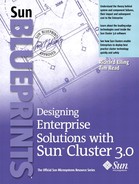Environmental Design
You should design the venue that contains the components of a highly available system to reduce or eliminate outages that are the result of environmental effects. Loss of power, excessive heat, floods, and fire can cause system outages. Place the system in a location where people can work safely. Consider the following environmental design tasks and features:
Define the procedures to be used when an environmental failure occurs. Test these procedures regularly.
Implement redundant power sources. Uninterruptible power supplies (UPSs), generators, and multiple power grid connections help provide power supply redundancy. If possible, use separate power feeds with different paths to multiple substations to help eliminate the failure mode in which a substation power failure occurs.
Implement an automatic switchover to alternate power sources. Automatic transfer switches (ATSs) are preferred over manual switches for switching between multiple power sources.
Implement automatic monitoring and alarms, and multiple air cooling units, if possible. Proper cooling requires both temperature and relative humidity control.
Monitor and control airborne contamination. Particulate matter and dust can clog air filters, causing excessive heat buildup. Conductive materials such as metal filings can cause short circuits. Corrosive materials such as salt spray and quicklime dust can cause failures in electrical components, wiring, and connectors.
Use fire suppression equipment that does not cause permanent damage to electronic equipment—FM-200, halon (if permitted), carbon dioxide fire extinguishers, and so forth. In earthquake-prone areas, local codes may require equipment to be secured to the floor.
Use flood and fire detectors and test them regularly. Natural disasters such as floods, fires, and earthquakes can cause system outages.
Label all components clearly. Clear labeling is especially important for redundant systems because there are multiple, identical components. Good labeling helps prevent failure modes, such as the field service person turning off the power to service an active component.
Implement a cable management system that clearly labels and routes cables. Secure the cables routed inside cabinets according to the manufacturer's specifications.
Install all equipment according to manufacturers' specifications.
Restrict physical access to the site and the system to help prevent accidents caused by unauthorized personnel.
Perform high-level fault analysis of the data center infrastructure.
